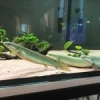Hi Jason,
Yep, we still meet monthly, though a fairly small group. We meet as a combined group with ANGFA WA, alternating interests. If you, or anyone is interested in joining us, drop me a PM for details of meeting dates/venue.
Cheers, Syd.
- Westie likes this




 Find content
Find content



